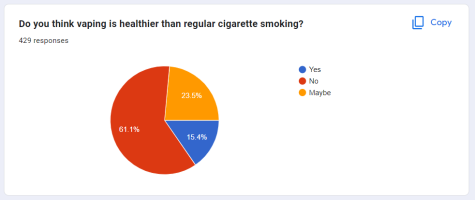“Addictive and harmful…”
March 3, 2023
Many people suffer from the addiction of smoking cigarettes. Creating an E-cigarette, invented in 2003 by Chinese pharmacist Hon Lik, was initially to develop a device to serve as a substitute for conventional smoking that was supposed to be better for your health.
A vape is a battery powered device that creates a water vapor that contains nicotine. The earliest vape devices looked like cigarettes. Newer models look like a USB flash drive or small pod. Vapes come in all different sizes and shapes.
The juice that the vape needs to create the water vapor contains many harmful chemicals, but the main ones are acetaldehyde, acrolein, and formaldehyde. According to the American Lung Association, “Those harsh chemicals can cause lung cancer, along with cardiovascular (heart ) disease.”
Most e-cigarettes contain nicotine. According to the Centers for Disease Control, “Nicotine is highly addictive and can harm adolescent brain development, which continues into early to mid-20s.” Using nicotine in adolescence can harm the parts of the brain that control attention, learning, mood, and impulse control.
A Santa Fe High student who wishes to remain anonymous said, “I was introduced to vaping in seventh grade. From then on I haven’t been able to stop…. From smoking for such a long time, I’ve noticed the effects it’s had on my body and lungs but I’m unable to stop due to the addiction.”
According to the CDC, “In 2022, 2.55 million U.S. middle and high school students used e-cigarettes in the past 30 days, including 3.3% (380,000) of middle school students and 14.1% (2.14 million) of high school students.”
In a schoolwide survey at Santa Fe High, 429 students answered a question about whether they believed vaping is healthier than regular cigarettes. Here are the results of that survey:

Scientists are still learning about the long-term effects of e-cigarettes, but there are certainly short-term effects. According to the American Lung Association, “Individuals should watch for signs of cough, shortness of breath, chest pain, nausea, vomiting and/or diarrhea…. These may be signs of lung damage.”
Vaping also affects people with asthma. According to the American Lung Association, “Vaping can make asthma and other existing lung diseases worse.” In addition, “Breathing in the harmful chemicals from vaping products can cause irreversible [cannot be cured] lung damage, lung disease and, in some cases, death.”
As of October 2019, more than 1,080 cases of vaping-related lung injuries, from 48 states and one U.S. territory, have been reported, according to the CDC.
E-cigarette manufacturers market to teens because they are easily convinced to buy and use vapes. Author Janet Hoek from The Conversation says, “To address evidence of underage sales and findings that more than 50% of young people reported buying vaping products from dairies, we need greater monitoring and stronger penalties for stores found to have sold vaping products to minors.”
If you’re a teen struggling with trying to quit vaping, talk to your doctor or another health care professional about quitting vaping. You can also go onto websites for support such as Truth Initiative or Smokefree Teen for support on quitting vaping.


